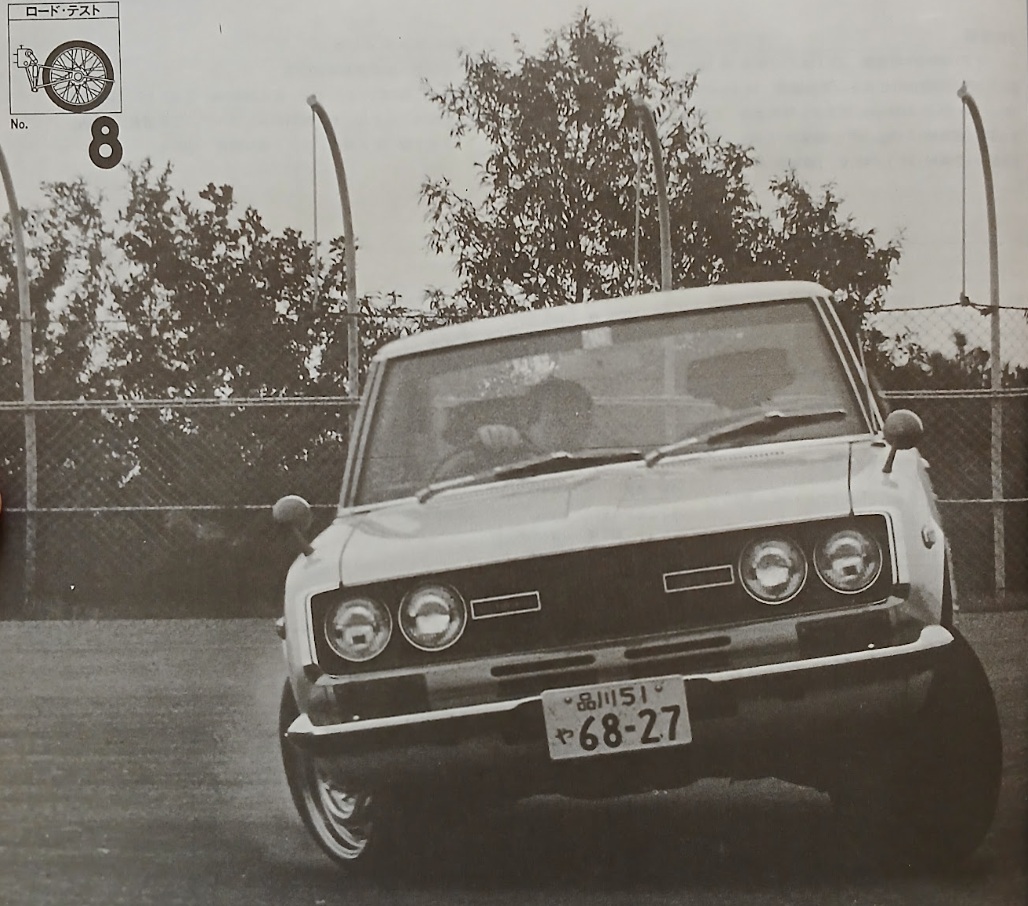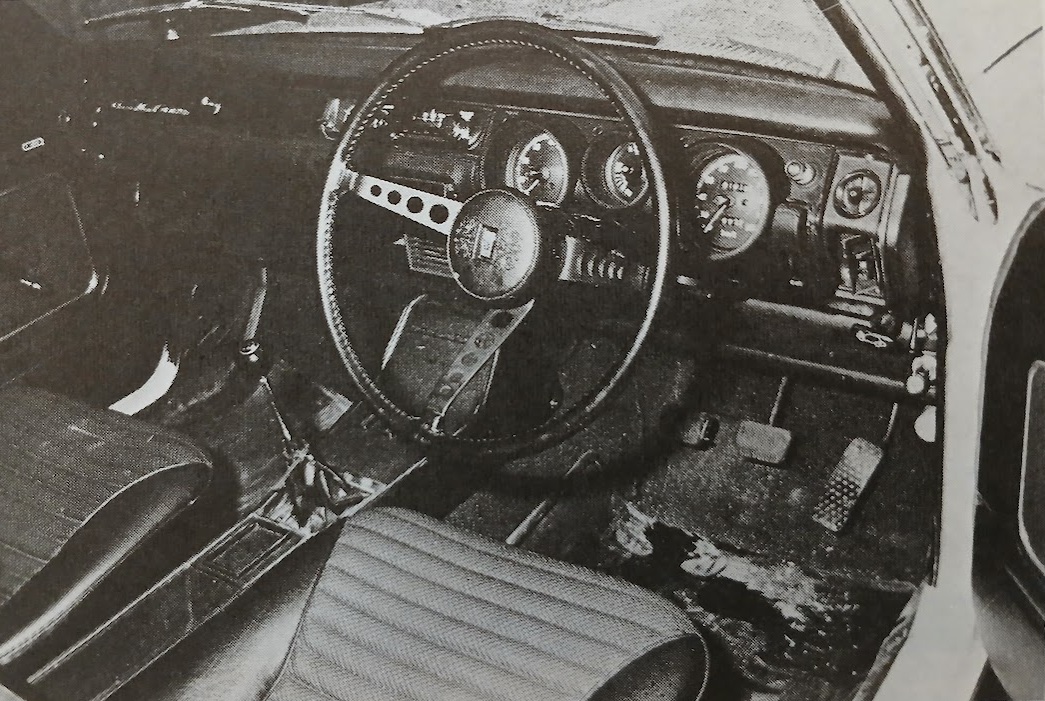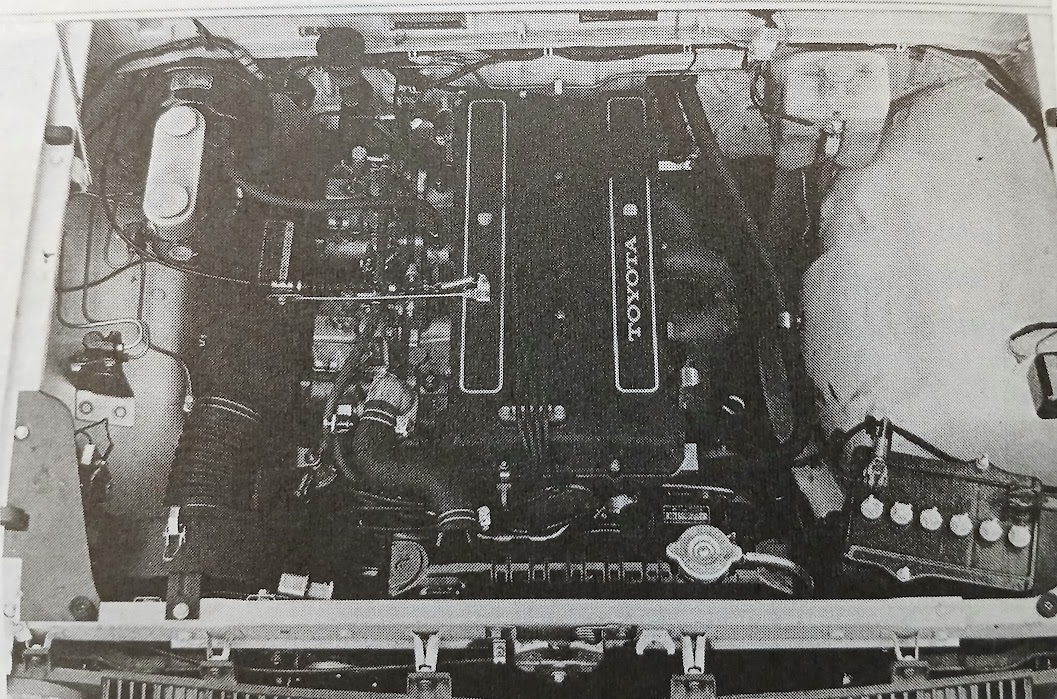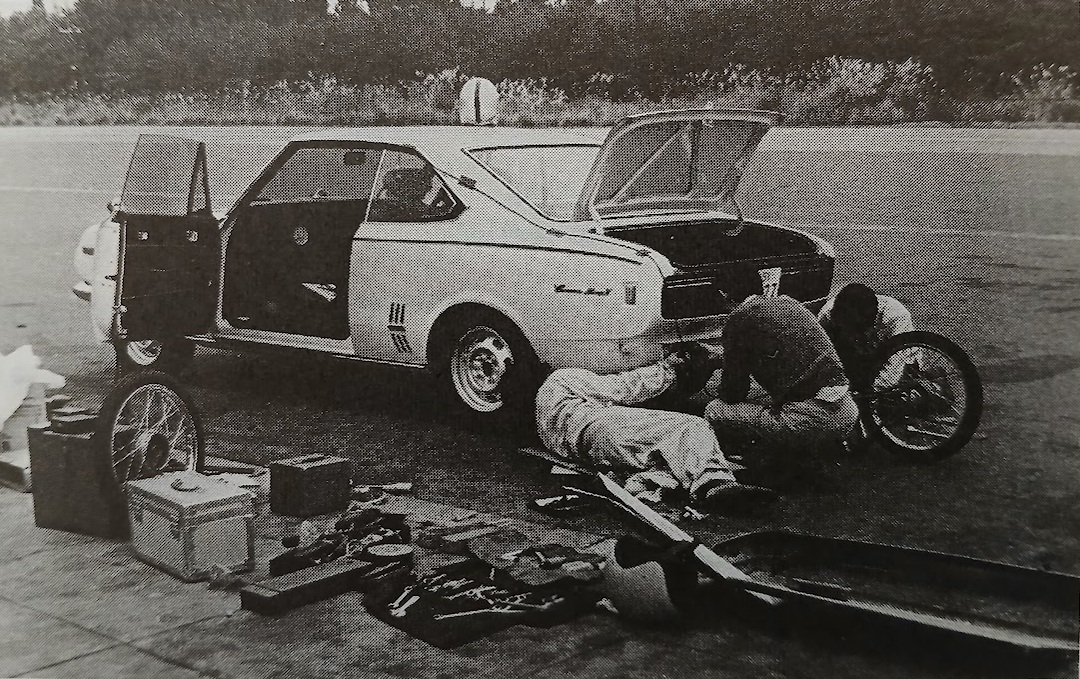Toyota Corona Mark II GSS (1970)
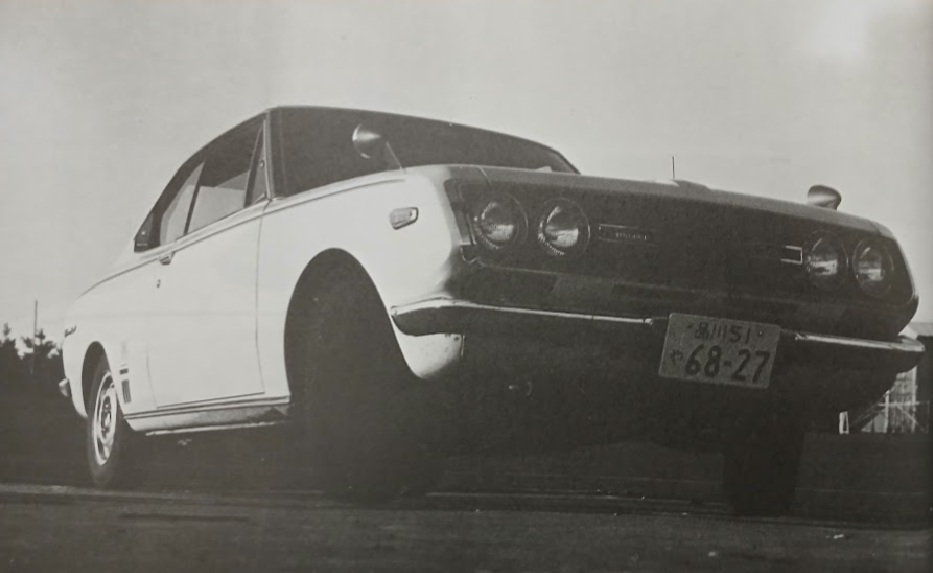
Publication: Car Graphic
Format: Road Test
Date: January 1970
Author: “C/G Test Group” (uncredited)
Summary: 140ps twin-cam engine, smooth and relatively quiet up to 7000+rpm, extremely high cruising speed, good flexibility at low rpm, sturdy 5-speed gearbox that is comfortable to use even in the city, radial tires give great cornering power, comfortable bucket seats, slightly rough ride from the rear suspension.
Road testing the Toyota Corona Mark II GSS
The GSS (internal name RT75-M) is the hottest Mark II, with a new DOHC 1858cc engine in a body that is basically the same as the existing 1900 Hardtop SL (RT72-S). It is a car that can be said to continue the glorious tradition of the Toyota 1600GT (RT55/55-M), which dominated touring car races until the first half of 1969.
Before we get to the road test, let’s briefly explain the differences between the Mark II GSS and the conventional SL. The new 10R engine uses the same 1858cc cylinder block as the 1900SL’s 8R-B, with almost no modifications (four new 5mm water holes were added to improve cooling around the exhaust valves in the cylinder head, and the oil level gauge was moved to the other side as it interfered with the twin Solex carburetors). The cylinder head is a new DOHC design made of die-cast aluminum alloy that incorporates a great deal of experience gained from the RT55’s 9R engine (which was, of course, a DOHC).
The combustion chamber is fully machined and hemispherical, with the intake and exhaust valves positioned at an angle of 64° to each other (32° to the cylinder axis) to form a cross flow. The valve diameter is large at 45mm for intake and 37mm for exhaust, and stellite steel with excellent heat and wear resistance is welded to the face of the exhaust valve head. The intake valve stem is chrome plated and the exhaust valve is Tufftride treated to improve wear resistance.
The DOHC is equipped with a two-stage double roller chain, and since this engine is designed with particular emphasis on practical use around town, the intake port is narrowed to the extent that intake resistance does not increase at high speeds, and the exhaust valve is narrowed to the extent that intake resistance does not increase at low speeds. Consideration has been given to increasing the flow rate and ensuring good atomization of the mixed fuel. Similarly, the valve timing has been improved without sacrificing torque at low speeds, and the valve overlap is only 36°, small for a DOHC (the same as the SL, though the cam profile is different).
To improve balancing at high speeds, the weight difference between the pistons is kept within 2g, and the connecting rods are also kept within 3g. The connecting rod design is different from the 8R-B, and the bearing cap is not fastened with a bolt and nut, but with a thread cut on the connecting rod side and a reamer bolt. The curved shape of the shaft is also made gentler, and the oil outlet hole to the cylinder is also closed, to avoid stress concentration as much as possible. Two Solex 40PHH-II carburetors are used.
The result of all these changes are that, while the SL’s 8R-B type engine generates an output of 110ps/4000rpm and a maximum torque of 15.5kgm/4000rpm, the GSS’s 10R generates 140ps/6400rpm and 17.0kgm/5200rpm. Equally impressive is that the engine’s service weight is 170kg for the GSS, and 168kg for the SL. This difference of only 2kg, despite being a DOHC, is likely due to the use of light alloy for the cylinder head.
Taking heavy-duty use into consideration, the clutch is a 224mm diameter diaphragm type (the SL uses a 200mm diameter coil spring type) similar to that used in the 2000GT. The gearbox is based on the 5-speed (fifth gear being an overdrive) used in the RT55 and 2000GT, but the gear ratio has of course been changed to match the power characteristics, and significant improvements have been made, including an increase in the capacity of the first and second gear synchros, tooth surface grinding, and reduced backlash. The limited-slip differential is the same one used in the RT55. The standard final drive ratio is 4.38, with 4.63 and 4.88 available as dealer options. The wheels are 5J x 14, which are larger and wider than the SL’s 4J x 13. The standard tires are 6.45S-14-4PR, with 6.45H-14-4PR and 165SR-14 available as manufacturer options. The wheels themselves are also different with small caps that make them look capless at first glance.
The suspension is basically the same as that of the SL, but there are some differences. First of all, in the front suspension, the pins on the upper arms are oil-lubricated metal threaded bushes (the SL has oil-free rubber bushes), aiming for more precise steering. The number of rear leaf springs has been increased to five, raising the spring constant to 1.95kg/mm (the SL has four, with a spring constant of 1.7kg/mm). The vehicle height is 10mm lower than the SL. Also, to deal with sudden torque fluctuations, a torque rod has been added to the rear axle.
The brakes are also stronger than those of the SL. The front brakes are Girling S16-type discs with an increased diameter of 258mm (the SL’s have a diameter of 244mm). The highly fade-resistant M33S mads (the SL has M2200) are standard, with DS-11 pads available as a dealer option for competition use. The rear brakes are of the leading/trailing shoe type with 229mm diameter Alfin drums. Of course, like the SL, they are equipped with a vacuum servo, and the rear wheel circuit has a proportioning control valve that reduces the hydraulic pressure to the rear wheel circuit when it rises above a certain level, preventing the rear wheels from locking up prematurely.
The vehicle weight is 1050kg, 30kg heavier than the SL, but since the power output has been increased by 30ps, the power-to-weight ratio has improved significantly from the SL’s 9.3kg/ps to 7.5kg/ps. As a comparison with direct rivals, the Skyline 2000GT-R’s power-to-weight ratio is 7.0kg/ps, while the Bellett GTR’s is 8.1kg/ps.
The performance of the Mark II Hardtop GSS is best explained by comparing it with the data of the C/G 1900 Hardtop SL, which we purchased exactly one year ago and also tested at Yatabe. We were highly impressed to see that the GSS’s high-speed performance (which is undoubtedly world-class for a practical, full five-seater vehicle) was achieved without sacrificing any low-speed flexibility. Starting with the top speed, we averaged 184.7km/h around the 5.5km circuit at Yatabe (unusually, the speed for the 1km straight section was lower at only 183.7km/h, which was probably due to the wind; the speed for the C/G SL was 170.1km/h). The engine speed was 6050rpm in fifth gear, nearly 1000rpm below the red zone. The C/G test group uses an accurate electronic fifth wheel speedometer to measure speed, but the speedometer on the test car was unusually lenient, indicating 209km/h when the actual speed was 184km/h. However, the test car was equipped with the optional 165SR-14 tires (radial tires have a slightly smaller rolling radius than bias-ply tires), so some of this may be due to the difference in effective diameter.
The acceleration performance was truly remarkable. With two people and a fair amount of test equipment on board (equivalent to almost four people on board), the 0-400m run was achieved in 16.6 seconds (the same as the catalog value, which is very rare in our experience), and 0-1000m was achieved in 29.9 seconds. The C/G SL’s times were 17.9 seconds and 34.0 seconds, respectively, so you can see how much the extra 30ps improves acceleration.
The DOHC engine always maintained good performance throughout the 700km of rigorous testing. Cold starts in the morning were a breeze with just two or three strokes of the pedal, without using the choke (a Solex strong point), and the warm-up time was very short. However, the idle was rough even by the standards of a hot sports engine, and the needle sometimes swung between 400 and 800rpm, but whenever we stepped on it, it responded well.
The rev counter is redlined from 7000 to 8000rpm. During acceleration tests, we always wound it up to 7200rpm in first gear, and it was still smooth, with no loss of valve response at all. However, the power dropped off rapidly over 7000rpm, so there was no point in revving it any higher. This engine is exceptionally well-balanced for a large inline four-cylinder, and the vibration period characteristic of four-cylinder engines was not observed anywhere in the wide rev range up to 7000rpm. Mechanical noise is also exceptionally low for a DOHC, at least in the cabin.
While the GSS’s engine is designed for high speeds, response holds up well even at low speeds. In the direct-drive fourth gear, the GSS can accelerate smoothly from as low as 40km/h (about 1500rpm). However, the power starts to come on at 2500rpm and above, and the engine starts to come “on the cam” only after exceeding 3500rpm. The excellent acceleration of the GSS at high speeds can be clearly seen in the acceleration times above 100km/h compared to those of the SL: 100 to 120km/h in 4.0 seconds (5.3 seconds for the SL), 120 to 140km/h in 5.9 seconds (8.6 seconds), and 140 to 160km/h in 9.5 seconds (18.9 seconds), making the GSS overwhelmingly faster.
At the same time, the GSS’s 40 to 80km/h acceleration time is 7.2 seconds in third gear (7.5 seconds for the SL) and 9.4 seconds in fourth gear (11.1 seconds), proving that the GSS’s low-speed range has not been sacrificed for the sake of high-speed performance. The SL is known for its flexibility at low speeds despite its high performance, but as these figures clearly show, the GSS, an even higher-speed model, is even easier to use at low speeds. For example, the Skyline 2000GT-R can only use up to third gear in the city, but the GSS can go into fourth gear at 40-50km/h, just like a normal family sedan. So in crowded city streets, you can forget about the existence of fifth gear and just drive it as if it were a four-speed SL.
The GSS’s 5-speed gearbox is a big improvement over the previous 1600GT and 2000GT. First of all, the gear ratios are well-matched to the power characteristics (the 1600GT’s was originally designed for the 2000GT, so third, fourth, and fifth gears were too close together, and first and second gear were too far apart). The gear ratios are 3.074 (3.143 in the 1600GT/2000GT), 1.838 (1.636), 1.256 (1.179), 1.000 (same), and 0.856 (0.844). This results in a much more efficient handover from gear to gear. Revved up to 7000rpm, the GSS could reach speeds of 58, 98, 143, and 174km/h in the first four gears. The shift feel was also much lighter and smoother than that of the 1600GT/2000GT. However, some staff members commented that the spring pushing the lever towards the third and fourth gear plane was too strong. Gear noise was generally quieter than in the 2000GTs we remember, but when we shifted from the direct fourth gear to the overdrive fifth, the reduced engine noise was partially canceled out by a light gear whine.
Even in the SL, 140km/h is a practical cruising speed that can be maintained without difficulty, but the GSS can cruise safely at 160km/h. Thanks to the overdrive, the revs are only about 5400rpm at this speed, leaving a sufficient safety margin. In the case of some cars, even when cruising at 160km/h is technically possible, it is unrealistic when the overall noise and vibration levels exceed the limits of human tolerance. However, in the GSS, these are well within acceptable limits. As mentioned above, the engine is smooth and quiet, and the good balancing of the two-piece propeller shaft is also worth mentioning. The exceptional straight-line stability also contributes greatly to easy high-speed driving. At Yatabe, even at speeds of over 180km/h, with just a light touch on the steering wheel, the car went as straight as an arrow, and no effort was required to stay on course. We maintained top speed and drove for about 15 minutes straight, and the engine’s condition did not change at all. The water temperature remained normal, and it idled normally after coming into the pits.
Naturally, fuel economy is slightly worse than the SL, but is rather surprisingly good for a DOHC 1.9-liter engine. In this regard, the GSS’s overdrive fifth gear gave it a clear advantage on highways. That is, fuel economy in fourth gear is generally about 15% worse than the SL’s top (fourth) gear, but in fifth gear it is roughly comparable to the SL, and at speeds of 140km/h or more, the GSS actually consumes less fuel. In terms of practical fuel economy, we observed 5.5-6.0km/l in urban areas, and 7-8.5km/l on national highways. The total average for the test distance was 7.2km/l.
The brakes are generally very good. The front discs are larger than those of the SL, and the pad material is M33S, which has a lower friction coefficient (high wear resistance), so slightly more pedal force is required than in the SL. Still, it is not heavy in absolute terms, and it demonstrated a deceleration of 0.95g at 40kg. The PCV in the rear wheel circuit is effective, and the braking force of all four wheels is well balanced even when braking suddenly. Another good thing is that there is very little nose dive. However, even these excellent brakes clearly showed fade in the rigorous 0-100-0 fade test (accelerating from a standstill to 100km/h, braking at the equivalent of 0.5g, and accelerating immediately after stopping; this is repeated ten times to see if fade occurs). The initial pedal pressure of 18kg began to fade rapidly around the seventh stop, and from the eighth stop more than double the pressure was required, making the brakes unstable. However, they quickly recovered after a few minutes’ rest. Basically, the brakes are reliable at high speeds.
The suspension is stiffer than that of the SL, and this feeling was even more pronounced because the test car was equipped with radial tires. Even with the standard air pressure of 1.5kg/cm² at both the front and rear, the ride feels quite rough with these tires. The rear suspension in particular gives the impression of being stiff, and at low speeds the car shakes strongly up and down. The suspension settings are clearly tuned for high speeds, and the ride becomes smoother as the speed increases.
The rear axle of the GSS is equipped with a torque rod. The SL does not have one, and when starting suddenly during acceleration tests, the leaf springs wind up too much, causing the rear axle to leap out of control and making quick starts difficult. With the GSS, the torque rod works in tandem with the limited-slip differential, making it easy to make clean, fast starts with minimal wheelspin.
The handling is surprisingly good for a car with a rigid rear axle. This is probably more due to the 165SR-14 Bridgestone radial tires on the test car than the reinforced suspension, but it maintains just the right amount of mild understeer up to the limit. The steering is not light, but it is very responsive and accurate. The tires’ grip is excellent, and they do not easily squeal or slide. Even if they do, it can be corrected with quick steering inputs. However, the standard variable ratio steering (19.5:1-21.5:1) is a bit slow and keeps the driver busy, so the optional 17.5:1 steering ratio is more suitable for this car, even if the steering force becomes heavier. This is a “must” for those planning to participate in gymkhana.
The Mark II suspension is well matched to the radial tires, and even without changing anything else, just adding radial tires improves the handling significantly, while hardly affecting ride comfort. We started our testing with the tire pressure at 2kg/cm², and when we measured the temperature after driving at high speed for about three hours at Yatabe, the temperature had risen only slightly and the pressure increased to 2.5kg/cm².
In terms of the interior, the main difference from the SL is the seats. They are semi-bucket seats with headrests attached, and are extremely comfortable. The seating position is slightly lower than in the SL, and there is no mechanism to adjust the seat height like in the SL. The steering wheel is wrapped in black leather, the throttle pedal is elongated to make heel-and-toeing easier, and some of the Hardtop SL’s standard accessories, such as power windows, rear window defogger, and power antenna, are made optional to reduce weight.
Let’s jump straight to the conclusion. The GSS is a high-performance five-seater hardtop that is easier to drive around town than the Skyline 2000GT-R, much roomier than the Isuzu Bellett GTR, and is slightly less expensive than either. It still costs about 200,000 yen more than its sister model, the 1900 Hardtop SL, but we can say with confidence that it is well worth it.
Postscript: Story Photos
